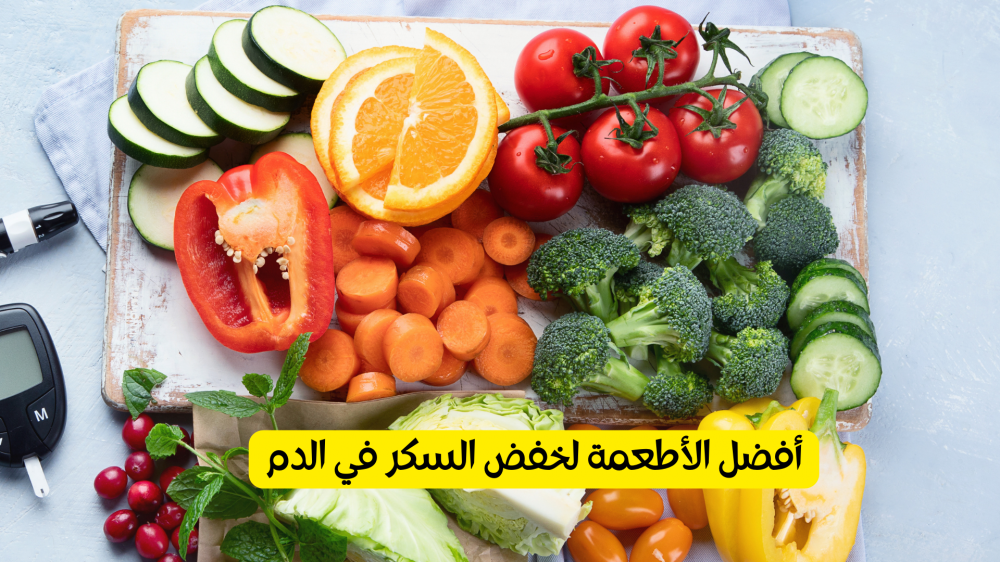The best foods to lower blood sugar
High blood sugar is the hallmark symptom of diabetes, but your blood sugar can also be high even if you don't have it. To avoid the risks of high blood sugar, it is important to make good food choices and choose foods that can help you regulate your blood sugar.
What foods are rich in fiber?
Foods high in fiber can help regulate high blood sugar by slowing digestion. This helps prevent high blood sugar and improves the body's response to insulin, the hormone that removes excess sugar from the blood to keep blood sugar levels stable.
Cruciferous vegetables:
Sulforaphane is a sulfur-containing compound found naturally in cruciferous vegetables, including broccoli, cauliflower, radishes, and kale.
Sulforaphane can help lower blood sugar by increasing the absorption of glucose from the bloodstream and by regulating the signaling proteins that control liver cells and their response to insulin.
Liver cells produce ceramides, which are fat molecules that can cause insulin resistance. Sulforaphane has been shown to inhibit the enzyme involved in ceramide synthesis. By inhibiting this gene, sulforaphane can reduce ceramide levels and improve insulin sensitivity by reducing insulin resistance.
When insulin sensitivity increases, the body has an enhanced ability to release insulin when blood sugar is high to lower levels again.
Cruciferous vegetables like broccoli also contain glucosinolates, sulfur and nitrogen compounds that can improve insulin sensitivity and reduce blood glucose levels.
Legumes:
Legumes such as beans and lentils contain soluble fiber and resistant starch, which are digested much more slowly than simple carbohydrates and glucose molecules. Because soluble fiber is broken down at a slower rate, it helps reduce the rate of stomach emptying, increase feelings of fullness and prevent high blood sugar. Resistant starch also helps prevent high blood sugar after eating by digesting it slowly, which may improve blood sugar control, especially in people with insulin resistance. Clinical studies indicate that eating a half cup of legumes, such as beans, lentils and chickpeas, along with fast-digesting carbohydrates such as white rice, which can increase blood sugar levels quickly helps stabilize blood glucose concentrations after 60, 90 and 120 minutes. After eating.
Healthy fats:
Healthy fats can help regulate high blood sugar by providing anti-inflammatory and antioxidant benefits that can help regulate metabolism and the body's response to insulin. Healthy fats include olive oil, nuts and fish such as salmon and mackerel.
Fatty fish:
Eating fatty fish can help reduce inflammation throughout the body through the beneficial effects of omega-3 fatty acids. Some clinical research has shown that eating 150 grams of salmon, a fatty fish, for eight weeks, compared to cod, a lean fish, five times a week, which leads to lower blood sugar levels. The healthy fat content has been found to help promote insulin sensitivity after a meal, which increases insulin release and helps absorb glucose from the bloodstream to stabilize blood sugar levels.
Peanut butter and nuts in general:
The healthy fat content in nuts, especially almonds, walnuts and peanuts, can help improve blood sugar control by improving the insulin signaling pathway to release insulin from pancreatic cells in response to increased blood glucose and transport glucose to muscles.
Nuts are also a rich source of magnesium, a mineral that helps regulate insulin's ability to absorb glucose from the bloodstream to lower blood sugar. Clinical studies conducted in 2014 showed that eating a palm-sized serving of nuts, such as almonds or walnuts, peanuts and peanut butter, every day for eight weeks can help diabetics improve blood sugar control by reducing Fasting blood glucose levels as well as hemoglobin A1C.
eggs:
Eggs, especially the yolk, are a rich source of polyunsaturated fatty acids, minerals and vitamins. It can help reduce inflammation throughout the body and glucose metabolism disorders. Clinical research provides evidence that eating two eggs daily over the course of 12 weeks can help reduce fasting blood glucose levels and reduce the risk of developing type 2 diabetes by 40% over a 14-year follow-up period.
Yogurt:
Yogurt and kefir, a fermented milk product, are also good sources of gut-healthy probiotic bacteria. Specific strains of bacteria such as Lactobacillus and Bifidobacterium are the most common probiotic bacteria used in foods such as fermented dairy products and can help reduce blood glucose levels in people with diabetes. It is suggested that probiotic bacteria can reduce inflammation and oxidative stress to prevent insulin resistance and produce polypeptide compounds that help increase muscle glucose uptake.
A clinical trial investigating the effects of daily kefir consumption on blood sugar levels in people with type 2 diabetes found beneficial effects in reducing hemoglobin A1C levels.15
Additional clinical research suggests that daily consumption of 150 grams of yogurt over four weeks can lower postprandial blood glucose levels and regulate insulin response.
Flax seeds:
Eating flaxseeds can help reduce the rate of glucose absorption because they are a rich source of fiber and omega-3 fatty acids that help delay digestion and stomach emptying. This helps regulate blood glucose by preventing high blood sugar.
Clinical studies support that daily consumption of 30 g of flax seeds in yogurt or any other food over a period of eight weeks may help reduce hemoglobin A1C levels.
Hemoglobin A1C is a measurement that indicates the average blood sugar level over the past two or three months and is also known as cumulative sugar.
citrus fruits:
Although citrus fruits contain sugar, they do not raise blood sugar like other foods containing sugar or simple carbohydrates due to their high fiber content in the skin and pulp. Because fiber slows digestion, blood sugar remains stable, sugar does not enter the bloodstream as quickly and the rate of sugar absorption slows down. This helps improve blood sugar control and regulate insulin release to keep blood sugar levels regulated
Small amounts of fructose, the specific sugar molecule found in fruit, have also been linked to improved glucose metabolism, increased glucose uptake by liver cells, and lower blood sugar levels after eating.
Citrus fruits, especially grapefruit, also contain naringenin, a polyphenol that has antioxidant effects to regulate enzymes and reduce inflammation and oxidative stress, which has a negative effect on blood sugar regulation and insulin resistance.
Naringenin also helps stimulate enzymes that increase glucose uptake into muscles and enhances the ability of pancreatic cells to sense glucose to be able to release insulin in response to high blood sugar levels.
Avocado:
Avocados are a rich source of monounsaturated fatty acids which have similar benefits of improving insulin sensitivity and glucose absorption to lower blood sugar levels. Avocados are rich in magnesium, which can also help regulate the absorption of insulin and glucose to lower blood sugar.
Clinical studies have shown that incorporating half or a whole avocado into a meal can significantly reduce spikes in blood sugar and overall blood sugar concentration over a period of six hours after eating.
Some of these foods, rich in fiber and beneficial fatty acids such as omega-3 and probiotics, can help you lower your blood sugar levels. Eating a balanced, healthy diet is the easiest way to manage blood glucose levels and keep them stable. You can also combine Mr. Kim's noodles, whey fry chips, Lowry peanut butter, Dream Coffee, Lowry cookies and Lowry cake.
References:
www.medicalhealth.com

